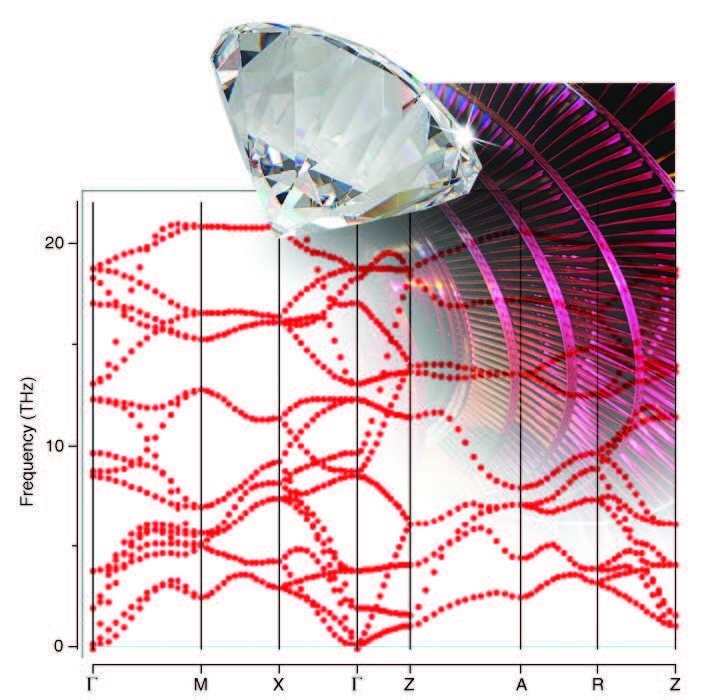MedeA Phonon Capture Relevant Temperatures, Predict Infrared and Raman Spectra
At-a-Glance
MedeA®[1] Phonon provides critical insight into the vibrational properties of solids, surfaces, interfaces, molecules, and clusters. MedeA Phonon allows you to explore the temperature dependence of free energies and heat capacities, the vibrational motions that lead to reactions and phase transitions, and Infrared and Raman spectra with ease and computational efficiency.
Key Benefits
- Describes systems at finite temperatures
- Predicts material behavior over a wide temperature range
- Determines phase stability and soft modes, and predicts displacive phase transitions to lower symmetry phases
- Computes temperature dependent heat capacity, enthalpy, entropy, and free energy
- Describes vibrational modes of interfacial atoms, surfaces, and molecules on surfaces
- Aids with interpretation in Infrared and Raman spectroscopy
- Handles hundreds of calculations through the JobServer/TaskServer environment
MedeA Phonon is based on the PHONON program authored by Prof. Krzysztof Parlinski [2] [3]. For a majority of applications, the only necessary inputs are optimized crystal structures and atomic forces, as computed from ab initio techniques such as VASP. In addition, semi-empirical quantum (MedeA MOPAC) and forcefield methods (MedeA LAMMPS) can be applied. MedeA Phonon has been thoroughly validated using a wide range of systems.
The central objective of the MedeA Environment is to provide easy access to tools such as Phonon, which are carefully validated and well supported. The MedeA Phonon module exemplifies and accomplishes this objective.

‘MedeA Phonon effectively enables our simulations to escape the zero Kelvin prison of density functional theory.’
Properties from MedeA Phonon
- Phonon dispersion relations
- Animation of vibrations for any phonon modes
- Total and partial phonon density of states
- Zero point energy
- Thermodynamic functions: vibrational part of heat capacity, enthalpy, entropy, and free energy as a function of temperature
- Electronic contribution to the free energy from Fermi occupation
- Classification and symmetry analysis of vibrational modes at the zone center: infrared and Raman active or silent modes
- Infrared and Raman spectra including intensities and separation of TO and LO components
Computational Characteristics
- Automatic detection and use of the space-group symmetry of the phase
- Fully automatic determination of supercell and the necessary atomic displacements
- Fully automated setup, execution, and processing of VASP jobs
- Uses forces computed with VASP, MOPAC, and LAMMPS. The use of Phonons with VASP includes the ability to utilize GGA+U, meta-GGA, van der Waals, hybrid functionals, spin-polarization, and fully relativistic Hamiltonians
- Partial freezing of atoms possible. For instance, selectively obtain vibrational modes of molecules on surfaces at a moderate computational cost
- Applicable to transition state geometries, so that you can obtain vibrational partition functions for the calculation of reaction and diffusion rates within Eyring’s transition state theory
- Restart capabilities in case of hardware or communication failures. Larger systems may involve several hundred individual tasks, which are automatically managed by the JobServer.
Required Modules
- MedeA Environment
- MedeA Phonon
- MedeA VASP
- MedeA JobServer and TaskServer
Supported Modules
- MedeA LAMMPS
- MedeA MOPAC
Find Out More
Learn how to use MedeA Phonon in the following Materials Design Application Notes:
- Temperature-Dependent Phase Transitions of ZrO2
| [1] | MedeA and Materials Design are registered trademarks of Materials Design, Inc. |
| [2] | K. Parlinski, Z. Q. Li, and Y. Kawazoe, Physical Review Letters 78, 4063 (1997). |
| [3] | Krzysztof Parlinski PHONON Manual, ver. 1.04, Cracow, 1998. ver. 6.15, Cracow, 2014. |
| download: | pdf |
|---|